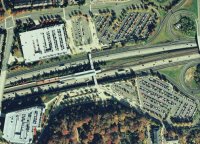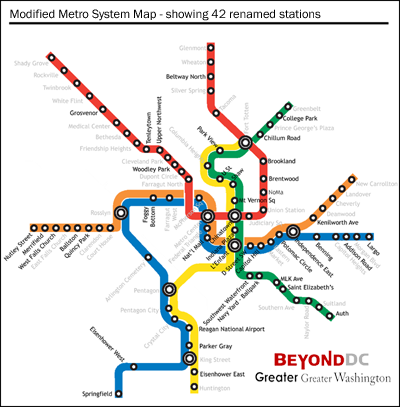|
Special Features





Image Libraries


|
|
Blog
The blogosphere has already got this covered, so I’ll be brief: Subsidizing gas stations would not be a smart policy for the District to enact. The District does not need to become more car-oriented.
Average Rating: 4.4 out of 5 based on 293 user reviews.
March 19th, 2009 | Permalink
Tags: government, transportation

On February 18 the Metropolitan Washington Transportation Planning Board removed the I-66 widening from its Air Quality Conformity Assessment document, denying Virginia one approval necessary for construction.
At today’s meeting of the Board, that decision was reversed as part of a compromise resolution put forth by Fairfax County member Cathy Hudgins. The compromise resolution approved by the Board restores the I-66 project to the AQCA, which means VDOT will be able to move forward with construction on the funded segment (section 1 out of 3). However, the resolution also requires Virginia to:
- Complete the current short-term I-66 BRT study by October.
- Conduct a second longer term multi-modal study considering HOV requirements, congestion pricing, managed lanes and road improvements, and to complete that study before any additional money is allocated to sections 2 or 3.
- Work with Arlington, Fairfax and Falls Church to provide unspecified mitigating enhancements to the local street/trail network in the corridor.
The compromise resolution keeps the widening moving forward while clearly sending the message to VDOT that the TPB expects it to take multi-modalism seriously. Ms. Hudgins crafted a very fine compromise despite being in a very difficult political position. She should be commended.
Average Rating: 4.6 out of 5 based on 227 user reviews.
March 18th, 2009 | Permalink
Tags: government, transportation

Last month I went to San Francisco. It was my first time there. I took a lot of pictures. Here they are, organized by topic:
I was most impressed by and am jealous of the architectural quality of the area around Union Square, the density of the Tenderloin neighborhood, and the prevalence of surface electric transit – not only rail, also trolley-bus. I was not impressed by BART, which seemed only marginally better than Caltrain (and despite rumors to the contrary, my Metro farecard didn’t work with the BART system).
I’ll spare the blogosphere the rest of the trip details, except to say that overall I come away a big fan.
PS: The pillow fight was awesome.
Average Rating: 4.4 out of 5 based on 299 user reviews.
March 15th, 2009 | Permalink
Tags: galleries

|

Northern Virginia needs more transit, but it doesn’t need half a dozen more of these. |
I like recently elected Congressman Gerry Connolly (D-VA). He understands the connection between transportation and land use and knows we can’t road-build our way out of congestion. He was fabulous as a Fairfax County Supervisor and I fully expect him to be fabulous as a Congressman.
But with all due respect to Mr. Connolly, he’s wrong about extending the Orange line from Vienna to Gainesville. We should absolutely have more transit in Northern Virginia, and in the DC-Fairfax-Manassas corridor specifically, but extending Metro along the median of I-66 would not be a good way to accomplish that.
Metrorail is the highest-capacity and most expensive kind of rail infrastructure available (short of mag-lev). This means governments should build Metrorail in places where that extremely high level of service is necessary. The sort of places that need such high level of service are urban downtowns, very dense inner city neighborhoods, and places where planners hope to create a downtown or a dense neighborhood. The median of an Interstate highway is none of those things, nor are far-out low density suburbs like Gainesville.
Now y’know, more transit is always good, so building a higher level than is necessary is OK (even desirable), except that we’re dealing with finite resources. Obviously if it were financially possible it would be ideal to have a 10, 000 mile-extensive mag-lev subway system operating under every major street in the region. Alas, since we have limited dollars, that isn’t possible.
Limited dollars are also why we shouldn’t be building Metrorail in a highway median to a low-density destination that will probably soon be served by other rail transit anyway. What should we do instead? How about THIS.
Instead of throwing billions of dollars into a single Metro line serving a single corridor that doesn’t need such high level of service to begin with, we should spend the same amount of money (or more, but either way) on improving regional rail and carpeting the whole region with streetcars/light rail. We could have this, which would be great but which we don’t really need, or we could have all this. For the same cost as it would take to extend the Orange line to Gainesville, we could extend VRE to Gainesville and drastically improve service frequencies on the entire VRE system and build a regional network of streetcars on several corridors around Northern Virginia.
Metrorail has been a glorious success and is worth every penny our region spends on it, but Washington area leaders need to understand that as magnificent as Metrorail is, it’s not the answer to every transit question that comes up. By matching the most appropriate transit mode to each corridor, we can spend our money more effectively and provide a higher level of transit service to a larger portion of our population covering a wider range of communities.
Average Rating: 5 out of 5 based on 153 user reviews.
March 13th, 2009 | Permalink
Tags: featured post, transportation

Now that the Silver line is a done deal and with yesterday’s post about renaming Metro stations fresh in mind, I want to give renewed attention to a point made back in 2008 about the proposed names of the Silver line stations in Tysons Corner:
Sooner or later we’re going to need names for these (stations) that people can use. Tysons East, Tysons Central 123, Tysons Central 7 and Tysons West are too cold. Who wants to be from a neighborhood named after a highway number, adjacent to another neighborhood named after a highway number? As suggestions, we’ll toss out (from east to west) Scott Run, Galleria Center, Westpark and Spring Hill.
The station names as currently proposed are horrid. They’ve been fine for planning purposes, but just won’t do for on-the-ground service. The good news is I recall hearing from one Fairfax County planner during an informal discussion that they may rename those stops (have a contest maybe?) but that nobody has made a decision. That was last year. With construction soon to begin, it’s time to decide for sure.
Update: Silver line representative Marcia McAllister clarifies: “Those decisions will be made by the Metro Board when the project is completed and transferred to them. The current station names are for design and construction.”
Average Rating: 4.5 out of 5 based on 170 user reviews.
March 11th, 2009 | Permalink
Tags: featured post, transportation


Approved and funded.
The Silver Line is a done deal. At 10:00 am this morning, right about as this post is being written, Transportation Secretary Ray LaHood is signing an official funding grant for $900 million. The first phase to Tysons Corner and Wiehle Avenue will open in 2013, and the remainder to Dulles Airport and Loudoun County in 2015.
More coverage at the Post and WTOP.
Woooooo!
Average Rating: 4.5 out of 5 based on 153 user reviews.
March 10th, 2009 | Permalink
Tags: featured post, transportation

According to Zach Schrag’s famous book about Metro history The Great Society Subway, the planners originally in charge of naming stations were told to keep it simple. In fact, says Schrag, the rule of thumb at the time was for no stations to be longer than two words. Obviously with names like U Street/African-American Civil War Memorial/Cardozo WMATA has moved away from that principle in recent years. These days many of the stations in the system are appended with some sort of slash-this or dash-something. Sometimes the change has made sense. The Federal government mandated that Reagan be added to National Airport, after all. A great many of the new names aren’t all that useful though; do we really need to know, for example, that students attending George Mason University sometimes use the Vienna station? GMU’s campus is over 5 miles from Vienna. The station does not directly serve the university. The name doesn’t have to be there.
At the same time, some stops could use a re-branding. When Dunn Loring opened it was envisioned as a park and ride serving commuters living in the Dunn Loring residential area north of the stop. The way things worked out most of the riders using the station are actually going or coming from the Merrifield commercial / industrial area south of the stop. The station originally called Dunn Loring would now be better named Merrifield.
It seems a good time to consider a look at the whole system. Thus the map below, illustrating a possible station renaming scheme. In some cases I renamed stations that are too long, or have too many acronyms attached at the end. In other cases I renamed to focus on a specific neighborhood or landmark. Where possible I’ve tried to stick to the two word maximum, but in a case or two have gone to three.
On the map gray station names are unchanged while black ones are those that have been modified.

Have your own ideas? Share them in the comments.
Cross-posted to Greater Greater Washington.
Average Rating: 4.8 out of 5 based on 278 user reviews.
March 10th, 2009 | Permalink
Tags: featured post, transportation

|

This guy is wrong wrong wrong. |
Don’t want anyone to miss this one: Americans took more transit trips in 2008 than in any year since the 1950s.
This is good news on so many fronts – quality of life, congestion, the environment, national security… and it was achieved under the obsolete, transit-hostile atmosphere of Bush-era Federal transportation planning. If transit can come back this strong without much institutional support, imagine what it might do with proper funding.
TEA time is going to be so exciting.
Average Rating: 4.7 out of 5 based on 217 user reviews.
March 9th, 2009 | Permalink
Tags: transportation

HERE.
Average Rating: 4.5 out of 5 based on 274 user reviews.
March 8th, 2009 | Permalink
Tags: transportation

The Georgetown Apple store has finally been approved. After actively antagonizing the Georgetown review board, Apple finally caved and made the minor changes the board first asked for months ago.
The approved design looks pretty much like the original and the fourth submission from last month, only the storefront glass is separated into several panels instead of a single big honking one.
Was that really so hard? Is it really so awful for the Mac brand?
I didn’t think so.
Average Rating: 4.5 out of 5 based on 257 user reviews.
March 5th, 2009 | Permalink
Tags: architecture

|
Media





Site
About BeyondDC
Archive 2003-06
Contact
Category Tags:
Partners
|























